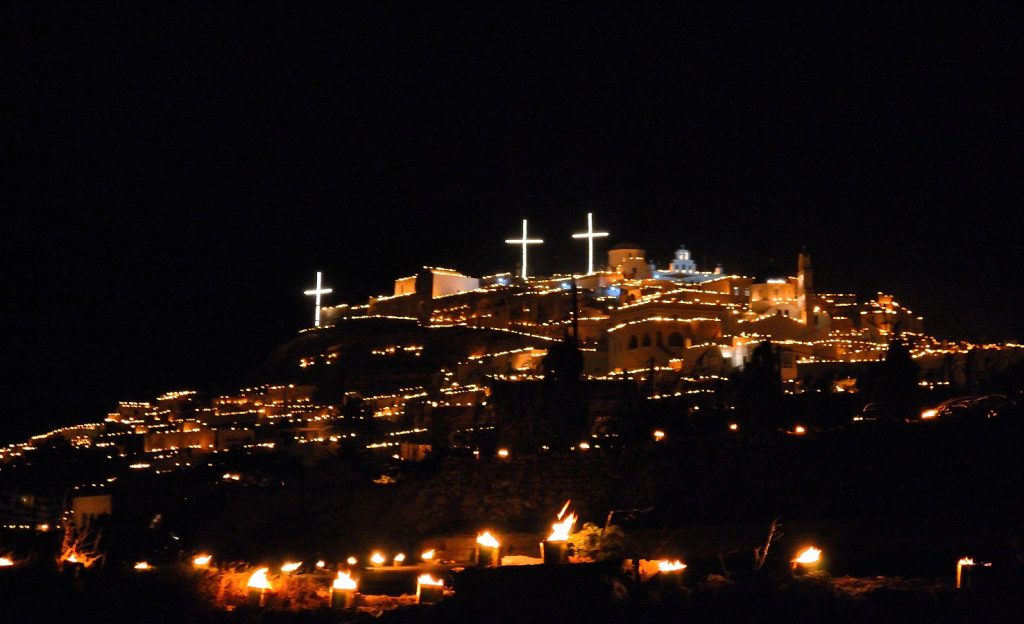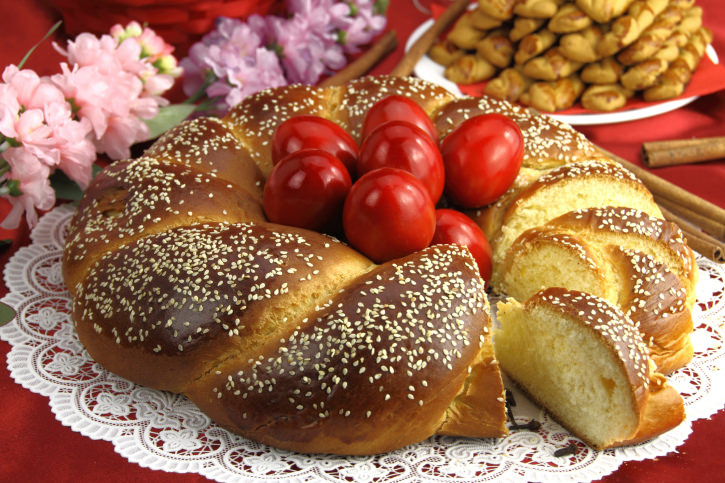By Marina Siskos
Orthodox Easter evokes the closest feeling to holiness. Greek Easter (Pascha) heralds the arrival of spring, hope and the atmosphere around Greece is replete with a rejuvenated sense of joy, community and of course, festivity, celebrating the eternal victory of life over death, through experiencing death itself, just as reverberated in the Resurrection hymn: “thanato, thanaton patisas” (θανάτω, θάνατον πατήσας). Originally, Easter apparently was regarded as commemorating the Crucifixion, but the interpretation was shifted quite early to the Resurrection (Barnett, 1949).
The Holy Week (Megali Evdomada) or the Week of Pathoi (the series of the sufferings and sorrows, representing the days prior to Christ’s crucifixion by the Romans in 30 A.D.) is the week prior to the Holy Easter, starting from Palm Sunday (Kyriaki ton Vayon) up to the Holy Saturday. It marks the final week of Lent, the forty-day period of fasting, prayer and penitence, and of which each day is dedicated to Jesus’ Pathoi (sufferings and sorrows) until the climaxing point of His Resurrection, both in the religious and the folkloric life of the Greeks. Easter is both a holy day for the Christian church and a secular, folk holiday (Barnett, 1949).
The word Pascha itself means “transition, passage, passover, medium,” revoking the passage from death to life. The Easter festival was celebrated quite early in the history of Christianity and developed out of the Jewish Passover feast in which Christ was regarded by the Jewish Christians as the Paschal Lamb (Barnett, 1949). Disputes between Jewish and Gentile Christians about the proper date for celebrating the feast led to a decree issued by the Council of Nicaea in 325 A.D. on the method of dating Easter, which became, and remains, a movable feast: Easter falls on the first Sunday after the first full moon after March 21, the date of the vernal equinox (Barnett, 1949).
Holy Thursday in Epirus
Holy Thursday is the most melancholic day of the Holy Week. It is associated with the preparation and the re-enactment, in the liturgy, of the Crucifixion of Jesus Christ. The Greek Orthodox Church brings to life the events of the Last Supper and Jesus’ last day before he was sacrificed on the Cross, as he dined for the last time with his disciples (Kolasa-Sikiaridi, 2017). The Last Super took place in a house in Jerusalem, wherein Jesus washed the feet of each of his disciples – a slave’s task at the time, an action of humility and Jesus wanted to teach his disciples how to be humble through his own example (Kolasa-Sikiaridi, 2017). Upon the departure of Judas from the dining table, Jesus handed the Sacrament of the Eucharist to his disciples (Kolasa-Sikiaridi, 2017). The events of the trial and the ascension to Golgotha, the hill of His execution, carry significant symbolism for the believers and are the focal points of Holy Thursday.
The custom of fire is re-enacted every year in Arta. The flame symbolises the fire that was burning outside the Praetorium as the sentence of the Roman prefect of Judaea was in progress (the toc, 2022). Early in the morning, youths of the St Theodora parish collect woods for the fire that lights in the church courtyard following the Crucifixion holy service. In the past, the wood for the fire was collected from the Arachthos riverbanks. The fire remains aflare for long hours, accompanying the host of believers who revive the rite every year.

On the same holy day, in secular life though, the spiritual preparation for the Resurrection is underway across the country: Greek households bake the tsourekia (sweet, traditional bread) that date back to the Byzantine days. The delicious aroma of baking tsourekia floats from the Greek flats and usually there is a bit of panic in the market to get equipped with all the ingredients. Tsourekia are also bought in the bakeries. There is gloom and despondency if the tsoureki doesn’t rise enough and turns out heavy and ingestible. Recipes are exchanged and secret ingredients are selectively revealed, promising an unfailing culinary outcome.
Sometimes, an egg is embedded in the tsoureki. The egg occupies, after all, an important position in the customs and beliefs of many nations: by its very nature it is rich in symbolism, “a capsule containing the germ of life” (Newall, 1984). In ancient times, eggs were buried with the dead and drawn on gravestones and only later did they become characteristic symbols of Easter: the church did not oppose it, although customs connected to the egg belonged to pre-Christian tradition in many countries, as the egg provided a fresh symbol of the Resurrection and the transformation of death into life.
Holy Friday in the Cycladic islands
In Santorini, in Pyrgos Kallistis, one of the five castle cities of the island perched atop the highest hill, Holy Friday assumes a suggestive imagery. Children line about 2000 flaming tin cans (tenekedakia) on every wall and rim of every roof. The funeral procession of Epitaph is invested in a unique spirit of reverence (Owen, 2022).

In Syros, the Catholic and the Orthodox Easter is celebrated together, offering a unique experience (HuffPost, 2020), under a special permission of the Pope, as a symbol of brotherhood and unity. On Holy Friday, the Epitaphs of the Catholic community descend from St George’s church, and in Hermoupolis, the Epitaphs depart from the Evangelical church to meet at the Miaoulis Square. In front of the stairs of the city hall, believers mourn and chant, accompanied by the Municipality’s Philharmonic Orchestra and Saint Nicholas’ choir. After all, most Easter customs and rites are shared for the Catholics and the Orthodox in Syros (HuffPost, 2020).
Holy Saturday in Corfu
Pascha in Corfu stands out in terms of grandiosity, pomposity and its unique acoustic rite of Mpotides, from every other island of the Eptanisa.
The influence of Western European civilisation is pronounced even in this purely Orthodox occasion (Kontarinis, 2016). Kontarinis (2016) informs that, in Corfu, Holy Saturday commences with an artificial earthquake, a tradition of the Panayia of Ksenon, assimilating the earthquake as mentioned in the Gospel. At 11.00 in the morning, following the service in the Cathedral, the bells start ringing joyously and it is time for the locals to start dropping, from their embellished balconies and windows, the Mpotides, the huge clay jugs, painted red and decorated with red ribbons, characteristic colour of the island of Corfu. The jugs are filled with water with the intent to produce ever more clash and clatter (Kontarinis, 2016).

Two concepts underlie the origins of the acoustic ritual: the first explains it as a representation of the evangelical chorale, according to which: “Lord, Resurrect me, so as to smatter them as if they were clay earthenware.” The second, says Kontarinis (2016), is a venetian influence: the Venetians would drop their old cookware in order to make room for the new ones, brought by the new year.
Tradition acts as the glue that coheres society. Even though remembrance and homage to the ancestry can be paid in nuanced, imperceptible ways in everyday life, holy days are landmarks of memory that bring the past to the lived experience of today, thus formulating the unique identity of each generation. Memory structures the self and it is activated in a social setting, observes Halbwachs (1992). It is impossible for individuals to remember in any coherent and persistent fashion outside their group contexts.
References
- Barnett, J. (1949). The Easter Festival-A Study in Cultural Change. American Sociological Review, Feb. 1949, Vol. 14, No. 1, p.p. 62-70. Published by: American Sociological Association. URL: https://www.jstor.org/stable/2086447.
- Eichler, L. (1925). The Customs of Mankind. William Heineman, Ltd; First Edition (January 1, 1925).
- Kolasa—Sikiaridi, K. (2017). How Greeks celebrate Holy Thursday, the Last Supper. The Greek Reporter. How Greeks Celebrate Holy Thursday, The Last Supper (greekreporter.com).
- Κονταρίνης, Δ. (2016). Μεγάλη Εβδομάδα στην Κέρκυρα Παρέα με τους «Μπότηδες». Easter 2016-PASXA. Queens College Special Collections and Archives. Contributed by: Aposotolos Zoupaniotis.
- Halbwachs, M. (1992). On Collective Memory. Transl/ed. LA. Coser Chicago: University of Chicago Press.
- HuffPost Greece. (2020). Το Πάσχα των Καθολικών στη Σύρο. HuffPost Greece. Το Πάσχα των καθολικών στην Σύρο | HuffPost Greece ΚΟΙΝΩΝΙΑ (huffingtonpost.gr).
- Newall, V. (1984). Easter Eggs: Symbols of Life and Renewal. Folklore, 1984, Vol. 95. No. 1 (1984). Pp. 21-29 Taylor and Francis, Ltd on Behalf of Folklore Enterprises. Ltd. URL: www. jstor.org/stable/1259756.
- Owen, W. (2022). Good Friday in Pyrgos, Santorini: Why You Shouldn’t Miss the Fire and Brimstone. No Bedtimes, No Borders: A Family Travel Blog. Good Friday in Pyrgos, Santorini: Why You Shouldn’t Miss the Fire and Brimstone — No Bedtimes, No Borders: A Family Travel Blog (nobedtimesnoborders.com).
- The Toc. (2022). Πάσχα στην Ήπειρο: Από τα Ταφικά Έθιμα έως τα Φωτίκια, τον Καγκελάρη και τους Μπότηδες στο «Διαβολοπάζαρο». The Toc. Πάσχα στην Ηπειρο: Από τα ταφικά έθιμα έως τα φωτίκια, τον καγκελάρη και… | Ελλάδα Ειδήσεις (thetoc.gr)


